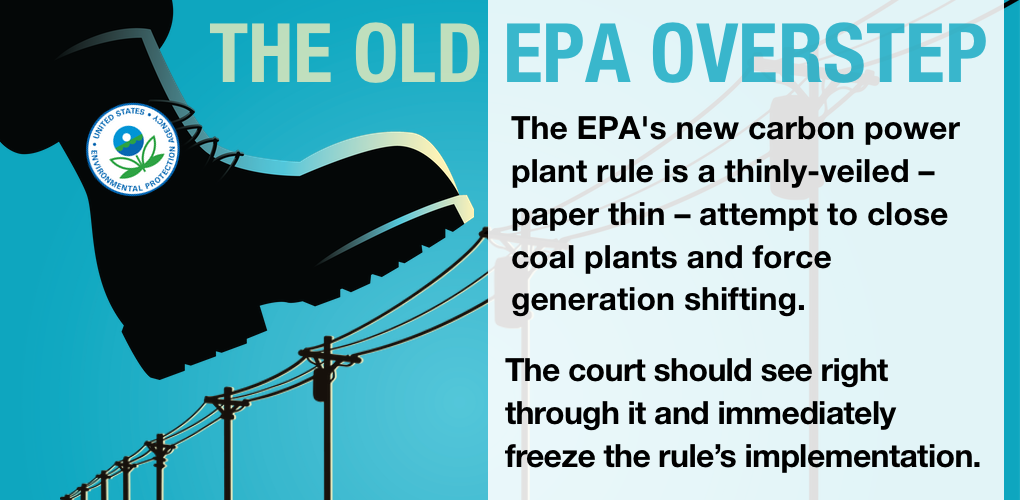
When the EPA Oversteps Its Authority, the Courts Must Act
Last week, the National Mining Association alongside America’s Power asked the U.S. Court of Appeals to pause the implementation of the U.S. Environmental Protection Agency’s (EPA) new carbon power plant rule – the so-called Clean Power Plan (CPP) 2.0. The NMA argues that the agency clearly overstepped its authority in the rule by requiring generation shifting, an EPA approach the Supreme Court already struck down as illegal in the 2022 decision in West Virginia v. EPA.
There’s urgency for the court to act. Under the CPP 2.0, utilities will begin feasibility work in June, kicking off the two-year process for states to develop compliance plans. In other words, coal plant operators are forced to act immediately to maintain even a hope of complying by the deadline. Implementation of the rule needs to be frozen because, as the NMA observes, “by the time this Court holds that the Final Rule is unlawful, it would be too late for a plant to turn back or recoup the expended costs.”
Generation Shifting
At the heart of the NMA’s challenge is EPA’s unlawful technology mandate and equally unlawful alternative courses of compliance. “The agency now offers coal-fired power plants a Hobson’s Choice: take a moonshot gamble or shut down,” the NMA and America’s Power argue in the stay request.
“Power plants can complete the impossible task of installing and implementing billion-dollar carbon-capture-and-sequestration (“CCS”) technology to continuously capture, transport, and store 90% of CO2 emissions before 2032. They can shift from coal to gas for at least 40% of the electricity they generate before 2030, and then retire by 2039. Or, they can simply retire before 2032 and hope to meet the fast-rising demand for electricity with non-coal generating resources.
“Since no power plant has ever achieved the 90% CCS that the Final Rule would mandate, and few plants can afford to attempt it now, the Rule functions as a mandatory deadline for coal-fired power plants to shut down. And once coal plants retire and the mines serving them close, the generation they once provided must necessarily shift to renewable, natural gas, or other non-coal resources to keep the lights on. So, EPA has once again mandated unlawful generation shifting.
“The Final Rule is unlawful because its 90%-CCS-before-2032 option is an unachievable canard for most coal plants, and the natural gas co-firing option is plainly the kind of ‘generation shifting’ prohibited under West Virginia. That leaves retirement, and the resultant shifting of generation resources, as the only viable option. This result reflects the same legal infirmities identified by the Supreme Court in 2022 and that were likely the basis of that Court’s stay of the Clean Power Plan in 2016.”
BSER? Hardly
Just how unlawful is the 90% carbon capture rate by 2032 as the proposed Best System of Emissions Reduction (BSER)? Recall that a BSER must be adequately demonstrated, reasonably reliable and not exorbitantly costly to be lawful.
Only one large U.S. commercial electric generating plant—the Petra Nova project—has ever been equipped with CCS, and that project involves only a “slipstream” CCS application, which means only about 33% of the unit’s exhaust is directed to the capture system. In addition, unlike EPA’s rule, which assumes a plant will run its capture system on its own power, Petra Nova relies on a separate natural gas combustion turbine to power the capture system.
Furthermore, just a single large plant anywhere has successfully achieved 90% CO2 capture—the Boundary Dam Power Station in Canada—and did so for only a handful of days shortly after commissioning, with technical issues since causing the facility to significantly reduce its capture rate.
While EPA pointed to the Boundary Dam project as an example of the viability of the technology in its proposed rule, SaskPower, the owner of Boundary Dam, submitted comments to EPA explaining that EPA was mischaracterizing its level of performance, stating that “only a portion of the total flue gas from BD3 can be processed by the CCS facility” and that the system now only targets 65% to 70% of total Boundary Dam Unit 3 emissions.
Trying to comply with this unlawful CCS mandate will be technically impossible and exorbitantly expensive. Consider the declaration from Prairie State Generating Company, which serves 2.5 million families in communities spanning eight states:
“Retrofitting Prairie State’s two units to comply with the Rule would cost at least $300 million in up-front expenditures on preliminary evaluations, design,and permitting over the next 24 months; approximately $4 billion for the CCS retrofit itself; and more than $176 million per unit, per year in additional annual operating and maintenance costs—all without any guarantee that these efforts and massive costs would keep the generating units online beyond December 31, 2038.”
EPA’s plan is unlawful. It’s a thinly-veiled – paper thin – attempt to close coal plants and force generation shifting. The court should see right through it and immediately freeze the rule’s implementation.
- On May 29, 2024
